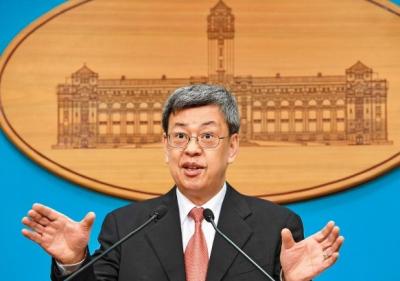Most countries do not ban or limit the use of crystalline silica in cosmetics, the Food and Drug Administration (FDA) said, adding that it would continue to reference international regulations and revise regulations accordingly.
The agency issued the remarks after an academic suggested banning or limiting the mineral’s use to reduce risk of lung cancer in women.
A Taiwanese biotech company in 2019 was producing cosmetics products in China, and Kuo Ching-tang (郭錦堂), then a China Medical University professor, was commissioned by the FDA to test 13 of the company’s products.

Photo: Taipei Times file
Some products were found to contain asbestos and were ordered to be removed from shelves, while 11 products had crystalline silica, also known as “free” silica, Kuo said.
Kuo said he randomly tested three cosmetic products this year — an eyeshadow, a powder foundation and a setting powder — from three different brands, and found that they were free of asbestos, but the eyeshadow and setting powder contained crystalline silica.
He suggested that the government ban or limit the chemical’s use in cosmetics to reduce the risk of lung cancer in women.
Quartz is the most common form of crystalline silica, and has stable chemical property and low solubility, said Kuo, a professor at National Changhua University and an on-site evaluation expert for the National Environmental Research Academy.
However, if people inhale tiny particles of crystalline silica, it can penetrate deep into the lungs and are hard to remove, he said, adding that prolonged exposure can lead to lung disease, lung inflammation and lung cancer.
Kou said most people have very low exposure to crystalline silica in the environment, but miners or people who work in stone cutting or processing, casting and refractory brick production might often be exposed to it, and the government has set exposure limits.
However, crystalline silica is used in cosmetic products to absorb oil and reflect light, which makes the skin look brighter and more delicate, he said.
It is easy to inhale as it is frequently used near the mouth and nose, which makes it more harmful, but there are no limitations to its use in cosmetic products, Kuo said.
Prolonged inhalation of high levels of crystalline silica increases the risk of lung cancer, so although it is unlikely to inhale high levels from cosmetics, the government could consider evaluating the risks to protect people’s health, Chang Gung Memorial Hospital Clinical Poison Center director Yen Tzung-hai (顏宗海) said.
Silicon dioxide, also known as silica, is found naturally in stone, sand, mud, dirt, air and water, and its common products include brick, glass, ceramic, plaster, granite, concrete, detergent, skin care and cosmetic products, the FDA said in response.
The International Agency for Research on Cancer (IARC) listed respirable crystalline silica in the form of quartz or cristobalite dust as a human carcinogen, because inhaling it might increase the risk of developing lung cancer, the FDA said.
However, most cosmetic products are in the form of liquid or cream, so the risk of inhaling it is low, it said, adding that if people who use powder cosmetics should dab an appropriate amount of product and avoid patting it too hard on the face to reduce the risk of inhaling the powder.
Countries, including the US, EU members, ASEAN members, Japan, China, Canada and South Korea do not ban nor limit the use of silica in cosmetic products, so the regulations in Taiwan are similar to those countries, the FDA said, adding that it would continue abiding by international regulations and revise regulations accordingly.
Asked whether silica is listed as a toxic chemical, the Ministry of Environment said the chemical widely exists in the natural environment and does not meet the definition for controlled toxic chemical substances, and that other countries have not listed it as a toxic chemical either.
Silicon dioxide exists in the natural environment in many forms, including crystalline and non-crystalline, and the most common form of crystalline silica is quartz, the National Environmental Health Research Center said.
Long-term inhalation of tiny-particle crystalline silica dust could increase the risk of silicosis, which is a lung disease, so it is listed as a Group 1 carcinogen by the IARC, but studies have not found non-crystalline silica to be carcinogenic to people or animals, the research center said.
Healthy people without lung disease would not experience negative health effects from exposure to larger-particle crystalline silica or non-crystalline silica, so they do not need to take particular measures in daily life to avoid silica products, it said.
Additional report by Chen Chia-yi

Several Chinese Nationalist Party (KMT) officials including Chairman Eric Chu (朱立倫) are to be summoned for questioning and then transferred to prosecutors for holding an illegal assembly in Taipei last night, the Taipei Police said today. Chu and two others hosted an illegal assembly and are to be requested to explain their actions, the Taipei City Police Department's Zhongzheng (中正) First Precinct said, referring to a protest held after Huang Lu Chin-ju (黃呂錦茹), KMT Taipei's chapter director, and several other KMT staffers were questioned for alleged signature forgery in recall petitions against Democratic Progressive Party (DPP) legislators. Taipei prosecutors had filed

Taiwan would welcome the return of Honduras as a diplomatic ally if its next president decides to make such a move, Minister of Foreign Affairs Lin Chia-lung (林佳龍) said yesterday. “Of course, we would welcome Honduras if they want to restore diplomatic ties with Taiwan after their elections,” Lin said at a meeting of the legislature’s Foreign Affairs and National Defense Committee, when asked to comment on statements made by two of the three Honduran presidential candidates during the presidential campaign in the Central American country. Taiwan is paying close attention to the region as a whole in the wake of a

NEW WORLD: Taiwan is pursuing innovative approaches to international relations through economics, trade and values-based diplomacy, the foreign minister said Taiwan would implement a “three-chain strategy” that promotes democratic values in response to US tariffs, Minister of Foreign Affairs Lin Chia-lung (林佳龍) said. Taiwan would aim to create a “global democratic value chain,” seek to capitalize on its position within the first island chain and promote a “non-red supply chain,” Lin was quoted as saying in the ministry’s written report to the Legislative Yuan submitted ahead of the legislature’s Foreign Affairs and National Defense Committee meeting slated for today. The Ministry would also uphold a spirit of mutual beneficial collaboration, maintaining close communication and consultations with Washington to show that Taiwan-US cooperation

President William Lai (賴清德) has appointed former vice president Chen Chien-jen (陳建仁) to attend the late Pope Francis’ funeral at the Vatican City on Saturday on his behalf, the Ministry of Foreign Affairs said today. The Holy See announced Francis’ funeral would take place on Saturday at 10am in St Peter’s Square. The ministry expressed condolences over Francis’ passing and said that Chen would represent Taiwan at the funeral and offer condolences in person. Taiwan and the Vatican have a long-standing and close diplomatic relationship, the ministry said. Both sides agreed to have Chen represent Taiwan at the funeral, given his Catholic identity and